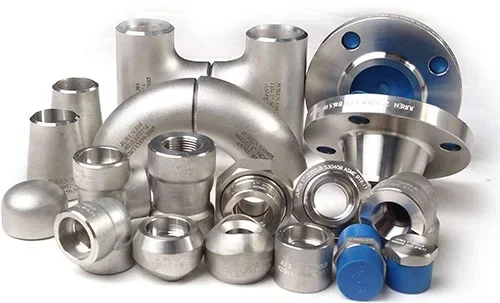Stainless steel pipe fittings appear rust spot how to deal with?
Stainless steel pipe fittings are a very common pipe connection. It has excellent properties such as corrosion resistance, high temperature resistance, and pressure resistance, so it has been widely used in various industrial fields. However, during the use of stainless steel pipe fittings, rust spots sometimes appear, which not only affects the aesthetics of the pipe fittings but may also affect the service life of the pipe fittings. So, how to deal with the rust spots on stainless steel pipe fittings? Let's take a closer look below.

Cause of rust spots
Before dealing with the problem of rust spots on stainless steel pipe fittings, we first need to understand the causes of rust spots. Generally speaking, there are several reasons for rust spots on stainless steel pipe fittings:
1. The surface of stainless steel pipe fittings has been mechanically damaged, such as scratches, abrasions, etc., resulting in the destruction of the protective layer on the surface of the pipe fittings, which makes the surface of the pipe fittings susceptible to corrosion by oxidation reactions.
2. The surface of stainless steel pipe fittings has been subjected to chemical corrosion, such as acid, alkali and other substances, which lead to the destruction of the protective layer on the surface of the pipe fittings, which makes the surface of the pipe fittings vulnerable to oxidation reactions.
3. The surface of stainless steel pipe fittings has been subjected to high temperature heat treatment, such as welding, heat treatment, etc., resulting in the destruction of the protective layer on the surface of the pipe fittings, which makes the surface of the pipe fittings susceptible to corrosion by oxidation reactions.
4. The surface of stainless steel pipe fittings is affected by the external environment, such as humidity, high temperature, high humidity, etc., which leads to the destruction of the protective layer on the surface of the pipe fittings, which makes the surface of the pipe fittings susceptible to corrosion by oxidation reactions.
Approach
Aiming at the causes of rust spots on stainless steel pipe fittings, we can take the following treatment methods:
1. Mechanical treatment
The mechanical treatment method refers to the removal of rust spots on the surface of stainless steel pipe fittings by mechanical means to restore the smoothness and aesthetics of the surface of the pipe fittings. Mechanical treatment methods include grinding, polishing, brushing and other methods, which can be processed by hand or mechanical equipment. However, the mechanical treatment method can only remove the rust spots on the surface, and cannot deal with the deep rust spots.
2. Chemical treatment
The chemical treatment method refers to the use of chemicals to remove the rust spots on the surface of stainless steel pipe fittings to restore the smoothness and aesthetics of the surface of the pipe fittings. Chemical treatment methods include pickling, alkali washing, electrochemical polishing and other methods, which can remove surface and deep rust spots. However, the chemical treatment method requires the use of chemical agents, which is harmful to the environment and the human body, and requires attention to safety.
3. Anti-corrosion treatment method
The anti-corrosion treatment method refers to coating a layer of anti-corrosion coating on the surface of stainless steel pipe fittings to protect the surface of the pipe fittings from the erosion of oxidation reaction. Anti-corrosion treatment methods include spraying, brushing, electroplating and other methods, which can effectively prevent rust spots on the surface of pipe fittings. However, the anti-corrosion treatment method needs to choose a suitable anti-corrosion coating, otherwise it will affect the service life of the pipe fittings.
4. Replace the fittings
If the rust spots on the surface of stainless steel pipe fittings are too serious, which has affected the service life of the pipe fittings, then we can only choose to replace the pipe fittings. To replace the pipe fittings, it is necessary to select reliable stainless steel pipe fittings to ensure the service life and safety of the pipe fittings.
Precaution
In addition to the above treatment methods, we can also take some preventive measures to avoid rust spots on stainless steel pipe fittings. The specific measures are as follows:
1. Strengthen the maintenance of pipe fittings, regularly check whether there is damage or rust on the surface of pipe fittings, and deal with them in time.
2. Select stainless steel pipe fittings with reliable quality and avoid using inferior pipe fittings.
3. Apply a layer of anti-corrosion coating on the surface of the pipe fittings to increase the corrosion resistance of the pipe fittings.
4. Avoid the surface of the pipe fittings from being affected by mechanical damage, chemical corrosion, high temperature heat treatment, etc., so as to protect the protective layer on the surface of the pipe fittings.
In short, rust spots on stainless steel pipe fittings are a common problem, and we need to take appropriate treatment methods and preventive measures to ensure the service life and safety of pipe fittings. When dealing with the problem of rust spots on stainless steel pipe fittings, we need to choose the appropriate treatment method according to the specific situation, and we also need to pay attention to safety and environmental protection.
The Different Types of Steel Pipe Fittings
Causes of corrosion of stainless steel pipe fittings
Corrosion phenomenon and solution of stainless steel pipe fittings






